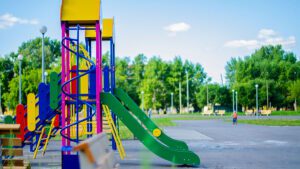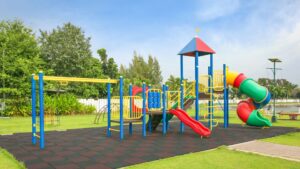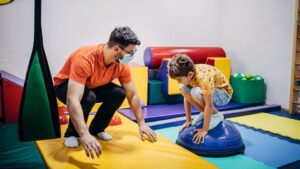Le jeu en douceur est l'une des activités d'intérieur les plus populaires pour les jeunes enfants, et ce pour de bonnes raisons. Ils sont sûrs, riches en sensations et conçus pour favoriser le développement physique, cognitif et social. Que vous soyez un parent décidant où emmener les enfants, un responsable de crèche planifiant un aménagement ou un exploitant de centre commercial évaluant les attractions, ce guide explique ce qu'est le jeu en douceur, ses avantages pour les enfants, où il peut être installé et ce qu'il faut prendre en compte lors du choix de l'équipement.

Définition rapide : Qu'est-ce que le soft play ?
Jeux d'enfants désigne les aires de jeux intérieures construites à partir d'éléments rembourrés, amortis et sans danger pour les enfants. Les éléments typiques sont les blocs de mousse, les fosses à balles, les structures d'escalade, les toboggans bas, les tunnels et les panneaux sensoriels. Tous les éléments d'un environnement de jeux souples sont recouverts de vinyle ou de tissu doux, cousus à la machine pour une plus grande durabilité, et conçus pour minimiser les blessures pendant les jeux actifs.
Les jeux souples reproduisent les aspects aventureux des aires de jeux extérieures, mais les adaptent à la sécurité intérieure, aux petits espaces et aux groupes d'âge plus jeunes. Il est idéal pour les tout-petits et les enfants d'âge préscolaire, mais les installations modernes comprennent souvent des zones pour les enfants plus âgés.

Types d'équipements de jeux souples
Les jeux souples se présentent sous de nombreuses formes et tailles. En connaissant les différentes options, vous pouvez choisir un équipement adapté à votre espace, à votre budget et à la tranche d'âge visée.
- Fosses à balles - zones sensorielles classiques remplies de balles en plastique, idéales pour les jeux tactiles.
- Blocs souples et ensembles modulaires - Formes en mousse que les enfants peuvent empiler, ramper et construire.
- Mini toboggans et rampes - des pentes douces pour que les tout-petits s'exercent à grimper et à glisser.
- Tunnels rampants et labyrinthes bas - encourager l'exploration et la conscience de l'espace.
- Animaux et formes sculptés - des pièces à thème (dinosaures, voitures, arbres) qui stimulent l'imagination.
- Panneaux sensoriels et murs d'activités - des stimuli tactiles, sonores et visuels pour le développement de la motricité fine.
- Structures de jeux souples à plusieurs niveaux - petites tours et plates-formes avec des barrières souples pour les enfants d'âge préscolaire.
- Aires de jeu de rôle intégrées - les étals de marché, les cuisines et les maisons en matériaux souples.
- Revêtement de sol souple interactif - des surfaces amorties avec des chemins ou des jeux imprimés pour des activités organisées.

Avantages des jeux de société pour les enfants
Le jeu en douceur est bien plus qu'un simple divertissement - c'est un outil de développement. Voici comment il aide les enfants à grandir.
1. Développement physique (motricité globale et fine)
Le fait de grimper, de ramper, de sauter et de se tenir en équilibre dans un jeu souple renforce les grands groupes musculaires. Les tâches de manipulation plus petites - appuyer sur un panneau, tourner un bouton - développent la motricité fine et la coordination œil-main.
2. Stimulation sensorielle
Les environnements de jeu doux offrent l'apport multisensoriel (toucher, vue, son, proprioception). Cela favorise l'intégration sensorielle, calme les enfants surstimulés et aide les nourrissons et les jeunes enfants à réguler leur sommeil et leur humeur.
3. Compétences cognitives et de résolution de problèmes
Choisir des itinéraires dans un labyrinthe mou, empiler des blocs dans une tour ou négocier un tour de rôle nécessite de planifier, d'ordonner et de résoudre des problèmes de base - un entraînement précoce des fonctions exécutives déguisé en jeu.
4. Résilience émotionnelle et confiance en soi
La maîtrise d'une petite escalade ou d'un nouvel obstacle renforce la confiance en soi. L'environnement peu risqué du jeu en douceur encourage les enfants à réessayer après un échec, ce qui favorise la persévérance et l'efficacité personnelle.
5. Compétences sociales et langage
Les espaces partagés encouragent l'interaction : les enfants apprennent à négocier, à partager, à prendre leur tour et à nouer des amitiés. Les aires de jeux de rôle développent le vocabulaire et la capacité à raconter des histoires.
Où peut-on installer des jeux d'éveil ?
Le jeu en douceur est flexible et peut être adapté à de nombreux lieux :
- Crèches, écoles maternelles et garderies - des jeux quotidiens axés sur le développement.
- Centres de jeux intérieurs et lieux de divertissement familial - des attractions génératrices de revenus.
- Centres commerciaux, cafés et galeries marchandes - une attraction familiale qui augmente le temps d'attente.
- Centres de loisirs et salles communautaires - des cours structurés ou des sessions de jeu ouvertes.
- Hôpitaux et centres thérapeutiques - des zones sensorielles pour soutenir le développement et le rétablissement.
- Maisons et domaines privés - de plus petites installations sur mesure pour les salles de jeux.
- Restaurants et hôtels - des équipements familiaux qui apportent une valeur ajoutée aux parents.

Conseils d'aménagement : créer une aire de jeux de qualité
Une aire de jeu bien conçue concilie le plaisir, la sécurité et les besoins opérationnels.
- Zonage par âge : Séparer les zones réservées aux tout-petits des zones réservées aux enfants d'âge préscolaire ou mixte.
- Des lignes de vue dégagées : Les parents et le personnel doivent pouvoir superviser facilement les enfants - éviter les barrières visuelles.
- Revêtement de sécurité durable : Utilisez des sols amortis faciles à nettoyer et antidérapants.
- Matériaux nécessitant peu d'entretien : Choisissez des housses en vinyle avec des coutures renforcées et une certification ignifuge.
- Conception accessible : Aménager des allées suffisamment larges pour permettre l'accès des poussettes et des fauteuils roulants dans la mesure du possible.
- Thème et couleur : Les palettes lumineuses et conviviales et les pièces à thème (jungle, océan, ferme) augmentent l'engagement.
- Zones de stockage et zones réservées au personnel : Prévoyez de l'espace pour le personnel, les premiers soins, les produits de nettoyage et un rangement ordonné.
- Planification de l'hygiène : Conception permettant un nettoyage fréquent grâce à des couvercles amovibles et essuyables.

Normes et réglementations en matière de sécurité
La conformité n'est pas négociable. Les opérateurs de jeux électroniques doivent respecter les normes de sécurité locales (par exemple, ASTM, EN 1176/1177 en Europe, et les codes nationaux pertinents). Pratiques de sécurité clés :
- Acheter du matériel testé selon les normes de l'industrie.
- L'installation doit être conforme aux directives du fabricant et doit être effectuée par un professionnel.
- Établir une liste de contrôle pour l'inspection et l'entretien de routine.
- Former le personnel à la supervision, aux protocoles d'urgence et aux procédures de nettoyage.
- Affichez des règles claires concernant l'âge et le groupe, ainsi que des limites de capacité.

Nettoyage et entretien
Le nettoyage est essentiel pour la sécurité et la réputation de l'établissement.
- Nettoyage quotidien : Essuyer les surfaces les plus touchées, passer l'aspirateur ou la serpillière sur les sols, vider les fosses à balles de tous les débris.
- Nettoyage hebdomadaire en profondeur : Laver les balles de la fosse à balles, nettoyer à la vapeur les panneaux en tissu lorsque cela est possible, désinfecter les panneaux sensoriels.
- Inspections régulières : Vérifier les coutures, les fixations, l'intégrité du noyau de mousse et remplacer rapidement les éléments usés.
- Journal de maintenance : Suivre les réparations, les incidents et les calendriers de nettoyage pour les audits de conformité et les assurances.
Choisir un fournisseur ou un fabricant
Lors de la sélection d'un fournisseur de jeux souples, il convient de prendre en compte les éléments suivants :
- Certifications de sécurité et les caractéristiques des matériaux (ignifugation, vinyle sans phtalates).
- Capacité de conception sur mesure (thèmes, dimensionnement sur mesure, ingénierie spécifique au site).
- Garantie et pièces de rechange politique.
- Références et portfolio des terrains de jeux - demander à voir les installations en fonctionnement.
- Service après-vente - l'installation, la formation du personnel et l'assistance à la maintenance.
- Pratiques de durabilité - matériaux recyclables et mousse/vinyle d'origine éthique.
Demandez 3 à 4 devis et comparez non seulement les prix, mais aussi les conditions de garantie, les délais d'exécution et les services inclus (installation, formation sur site, manuels).
Considérations commerciales : Retour sur investissement et idées de programmation
Pour les entreprises, le jeu en douceur est plus qu'une attraction - c'est une source de revenus s'il est bien positionné.
- Admission en libre accès (sessions chronométrées) génère une fréquentation régulière.
- Location privée et formules d'anniversaire sont des moteurs de revenus à forte marge.
- Cours et ateliers (activités sensorielles pour les bébés, gymnastique pour les tout-petits, yoga pour les parents et les bébés) augmentent le taux d'occupation en semaine.
- Adhésion et fidélité encourager les visites répétées.
- Ventes croisées de produits alimentaires et de produits de détailles cafés, les boutiques de souvenirs et les accessoires de fête augmentent les dépenses par visite.
- Engagements d'entreprises ou d'écoles développer les flux de revenus B2B.
Foire aux questions (courte)
Q : A partir de quel âge peut-on utiliser le soft play ?
R : Principalement les 0-6 ans pour les jeux souples classiques ; les enfants plus âgés peuvent utiliser des structures d'escalade plus grandes lorsque les zones sont séparées.
Q : Les aires de jeu sont-elles hygiéniques ?
R : Oui - avec des routines de nettoyage quotidiennes et des désinfectants recommandés par les fabricants, les jeux mous peuvent être hygiéniques et sûrs.
Q : Quelle est la durée de vie des équipements ?
R : Les jeux souples de haute qualité, s'ils sont bien entretenus, peuvent durer de 7 à 15 ans. Les housses en vinyle et la mousse peuvent nécessiter un remplacement périodique.
Q : Puis-je installer des jeux souples à l'extérieur ?
R : Certains produits modulaires sont résistants aux intempéries, mais la plupart des jeux souples sont conçus pour être utilisés à l'intérieur. L'utilisation en extérieur nécessite des matériaux résistants aux UV et des solutions de drainage.
Conclusion
Le jeu en douceur est un mélange puissant de sécurité, de stimulation sensorielle et d'amusement imaginatif. Ils favorisent le développement précoce dans les domaines physique, cognitif, émotionnel et social, tout en offrant des options d'installation flexibles pour les crèches, les détaillants et les lieux de divertissement. Qu'il s'agisse de concevoir une zone pour les tout-petits, de choisir des équipements pour une garderie ou de planifier un centre de jeux générateur de revenus, la priorité est donnée à la sécurité, à la clarté des lignes de vue, à la facilité d'entretien et au zonage en fonction de l'âge. Avec une conception et une programmation adéquates, le jeu en douceur devient un espace inestimable où les enfants apprennent, explorent et s'épanouissent.




